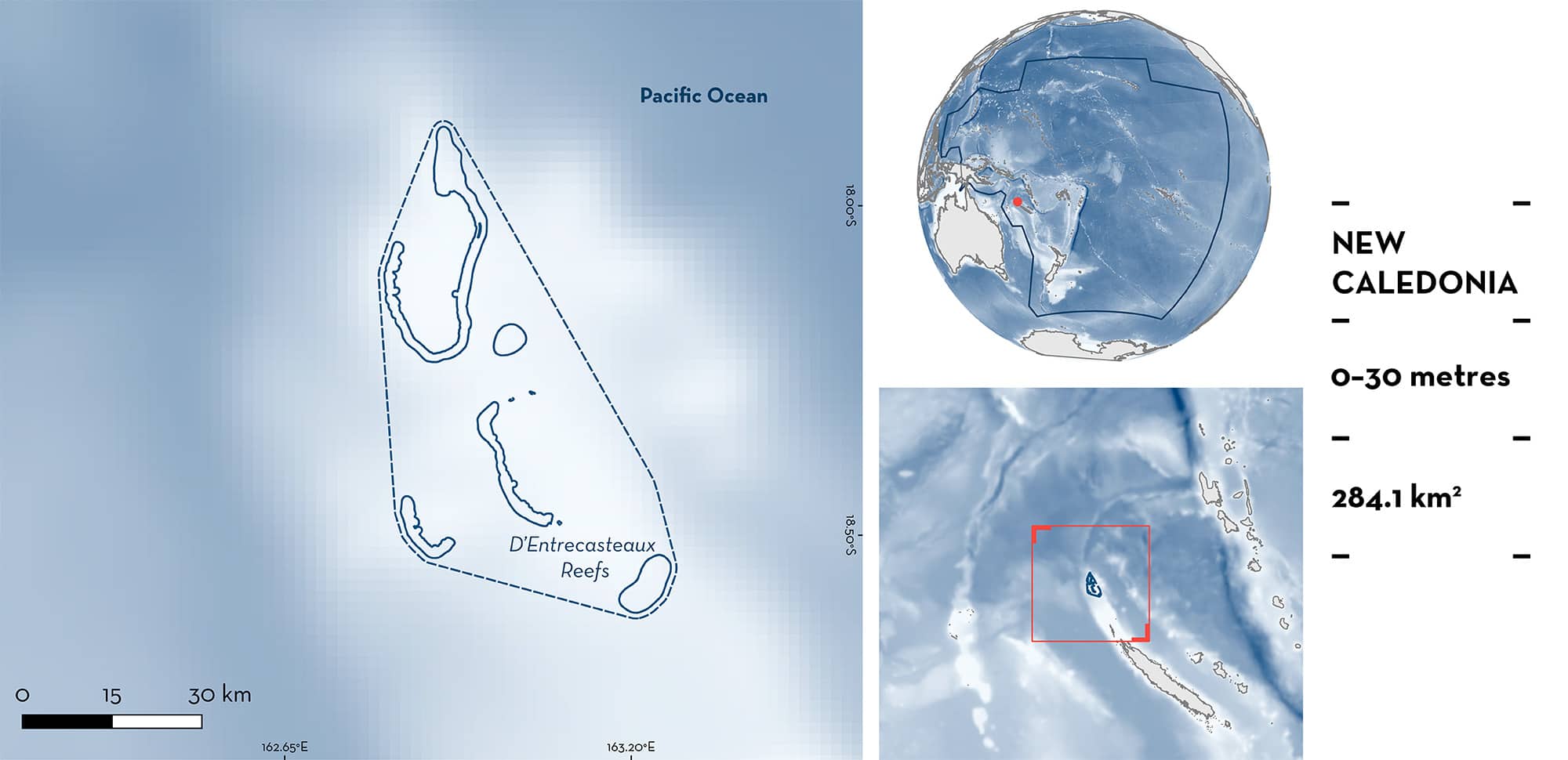ISRA FACTSHEETS
ISRA FACTSHEETS
NEW ZEALAND & PACIFIC ISLANDS REGION
D’Entrecasteaux Reefs
Summary
D’Entrecasteaux Reefs is located in northern New Caledonia. The area includes four atolls (Huon, Surprise, Pelotas, and Portail) and multiple reefs (e.g., Petit Gilbert, Grand Guilbert, and Merite) characterised by live and dead coral substrates with sandy patches. The area overlaps with the Récifs d’Entrecasteaux Marin Key Biodiversity Area and with the Récifs d’Entrecasteaux Marin Natural Park. Within this area there are: threatened species and undefined aggregations (Grey Reef Shark Carcharhinus amblyrhynchos).
Download factsheet
D’Entrecasteaux Reefs
DESCRIPTION OF HABITAT
D’Entrecasteaux Reefs is located in in the Coral Sea in north New Caledonia. It is found ~100 km from Belep Islands and ~180 km from the northern tip of Grande Terre Island. The area includes four atolls (Huon, Surprise, Pelotas, and Portail) and multiple reefs (e.g., Petit Gilbert, Grand Guilbert, and Merite). Huon Atoll is a barrier reef (~75 km long) surrounding a lagoon with a northwest opening and several small passes and includes Huon islet. It is the northernmost atoll in New Caledonia. Surprise Atoll is a barrier reef ~65 km with a west opening and includes three islets, Fabre, Le Leizour, and Surprise. The area is characterised by live and dead coral substrates with sandy patches (Pelletier et al. 2020).
The area overlaps with the Récifs d’Entrecasteaux Marin Key Biodiversity Area (KBA 2024) and the Récifs d’Entrecasteaux Marin Natural Park (UNEP-WCMC & IUCN 2024).
This Important Shark and Ray Area is benthic and pelagic and is delineated from inshore and surface waters (0 m) to 30 m based on the bathymetry of the area.
CRITERION A
VULNERABILITY
One Qualifying Species considered threatened with extinction according to the IUCN Red List of Threatened Species regularly occurs in the area. This is the Endangered Grey Reef Shark (Simpfendorfer et al. 2020).
CRITERION C
SUB-CRITERION C5 – UNDEFINED AGGREGATIONS
D’Entrecasteaux Reefs is an important area for undefined aggregations of one shark species.
Aggregations of Grey Reef Shark are regularly observed in this area and have been documented by underwater surveys, visual census, rotating video stations, acoustic telemetry, and Baited Remote Underwater Video Station (BRUVS) surveys (Vigliola et al. 2014; Wantiez et al. 2016; Juhel et al. 2017; Mallet et al. 2022a, 2022b; Bonnin et al. 2022; A Friedlander unpubl. data. 2024).
Between 2012–2014, underwater surveys (n = 253) were conducted along New Caledonia reefs. Surveys consisted of fixed-width transects (25 m long by 4 m wide at 10 and 20 m depths), distance-sampling visual census (50 m long by 10 m wide at ~15 m depth), and BRUVS (1 hour at ~20 m depth; Vigliola et al. 2014). Of these surveys, 41 were conducted in D’Entrecasteaux Reefs during November 2013, showing that Grey Reef Shark aggregate in the area (Vigliola et al. 2014).
Surveys with BRUVS (2012–2014) and distance-sampling visual census (1986–2014) were conducted at 385 sites for BRUVS and 2,790 sits for visual census (including 15 marine protected area) along New Caledonia with D’Entrecasteaux Reefs holding one of the largest abundances for sharks among all sites (Juhel et al. 2017). Grey Reef Sharks were recorded in 74% of BRUVS and in 62% of visual censuses with aggregations (3–6 individuals) regularly observed. These aggregations were among the second largest in all New Caledonia (Juhel et al. 2017).
Of 306 surveys with rotating video stations (deployed for 12 minutes from the boat and consisting of cameras rotating 60° every 30 seconds) conducted in 2015 (n = 109) and 2021 (n = 197), carcharhinids were observed in 44% of the stations with Grey Reef Sharks observed in 12% of the stations in 2015 (Schohn et al. 2017) and 7% in 2021 (Mallet et al. 2022a, 2022b). Further, of 32 fixed-width transect surveys conducted in the area in May and June of 2021 (2–10.5 m depths), aggregations of Grey Reef Sharks (n = 3) between 70–200 cm total length (TL) were observed in 22 of the surveyed stations (Wantiez et al. 2021, 2022).
Acoustic telemetry of 36 Grey Reef Sharks tagged and monitored in the area between 2015–2019 revealed high-residency to the area and limited movements with none of the sharks detected in other areas of New Caledonia (Bonnin et al. 2022). Deep oceanic waters between D’Entrecasteaux Reefs and other atolls and islands in New Caledonia seem to serve as a barrier limiting the movements of this species and highlighting the importance of this area for aggregations of isolated populations of Grey Reef Sharks. More information is needed to confirm the nature and function of these aggregations.
Download factsheet
SUBMIT A REQUEST
ISRA SPATIAL LAYER REQUEST
To make a request to download the ISRA Layer in either a GIS compatible Shapefile (.shp) or Google Earth compatible Keyhole Markup Language Zipped file (.kmz) please complete the following form. We will review your request and send the download details to you. We will endeavor to send you the requested files as soon as we can. However, please note that this is not an automated process, and before requests are responded to, they undergo internal review and authorization. As such, requests normally take 5–10 working days to process.
Should you have questions about the data or process, please do not hesitate to contact us.


